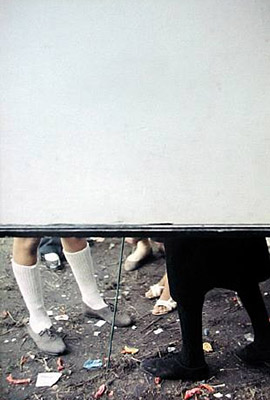A Portrait of Humanity
Nominate a Photo Icon Example: Text by Joseph Mayer, edited and adapted by Citizen Film.
Few photographers have ever been able to capture humanity in a photograph as well as Paul Strand. Strand took “Man, Five Points Square” in 1916 while in a cycle of anonymously photographing everyday New Yorkers. He sought to capture a true realness in people, so he would not set his own scenes when he wandered lower Manhattan. Strand was ingenious in his approach, using a side-mounted objective lens to take his photographs unnoticed. By applying this method, Strand was able to photograph his subjects in their most organic state. The resulting iconic photographs, namely “Man, Five Points Square,” are incredibly profound in the way they carry so much straightforward emotion.
“Man, Five Points Square” is amazing in how upfront it is. Strand deliberately cropped the photograph so that only the man’s face is shown. It is impossible to deduce nearly anything from the photograph because there are so few other details. There is no background at all, just gray and black color. The man’s jacket and hat are black and undetailed as well. There is not much light at all in this picture, but enough to reveal the anonymous man’s face.
What is so iconic about this photograph is the man’s facial expression that Strand captured. The viewer is unaware of what he is looking at, where he is going, or who else is present, so the actual setting is a complete mystery. While this might take away from certain photographs, “Man, Five Points Square” benefits immensely from being the most objective view attainable of a single facial expression. This very fact is the reason the subject’s soft yet serious gaze is a fascinating mystery.
“The portrait of a person is one of the most difficult things to do because in order to do it, it means you must almost bring the presence of that person photographed to other people in such a way that they don’t have to know that person personally in any way but they still are confronted with a human being that they wont forget.”
Paul Strand. Perhaps the most mesmerizing parts of the photograph are the man’s eyes. They resemble a battered soldier’s “thousand yard stare,” exhausted, weary and full of emotion. Hans-Michael Koetzle has marveled at the way Strand made his unknowing subjects, “an object of a psychological investigation.” Strand is celebrated for his ability to take photographs that allow the viewer to feel the humanity. It is difficult to look into the photographed man’s eyes without losing track of time for a moment, lost in a whirlwind of sympathy and curiosity.
[slideshow_deploy id=’2189′]
Paul Strand did not use his photography to send political messages or demand social reform. He was not a journalist obsessed with recording events of the time. When Paul Strand photographed people, he wanted to capture actual people in a way Stieglitz called “pure.” Koetzle described Strand as striving for, “the greatest amount of objectivity.” Strand achieved this breakthrough with “Man, Five Points Square.”
Sources
Images
Strand, Paul. Phillips, “Boy, Hidalgo, Mexico, 1933.” <http://www.phillips.com/detail/PAUL-STRAND/NY040213/188?fromSearch=Paul%20Strand&searchPage=1>
Strand, Paul. The Art of the Photogravure, “Man, Five Points Square.” <http://www.photogravure.com/collection/searchResults.php?page=177&view=medium&file=Strand_03_06>
Strand, Paul. Phillips, “Man in a Derby, New York, 1916.” <http://www.phillips.com/detail/PAUL-STRAND/NY040012/11?fromSearch=Paul%20Strand&searchPage=1>
Strand, Paul. Phillips, “The Mother, Luzzara, Italy, 1953.” <http://ww.phillips.com/detail/PAUL-STRAND/NY040012/22?fromSearch=Paul Strand&searchPage=1>
Strand, Paul. Phillips, “Mr. Bennett, Vermont” Portfolio III. <http://www.phillips.com/detail/PAUL-STRAND/NY040210/104?fromSearch=Paul%20Strand&searchPage=1>
Strand, Paul. Wellesley University, “Young Boy, Gondeville, Charrente, France” Portfolio III. <http://mobius.wellesley.edu/info.php?page=0&v=1&s=Strand%2C+Paul&type=browse&t=objects&f=maker&d=>
Strand, Paul. Phillips, “Young Farmer, Po Valley, 1953.” <http://www.phillips.com/detail/PAUL-STRAND/UK040212/59?fromSearch=Paul%20Strand&searchPage=1>
Strand, Paul. David Campbell, “Young Woman – Untitled.” <http://devincampbell.com/blog/?attachment_id=2649>
Research Material
Koetzle, Hans-Michael. “Paul Strand.” Photo icons. Köln: Taschen, 2002. 169-75.
Strand: Under the Dark Cloth. Dir. John Walker. Documentary. Kino International, 1989.














